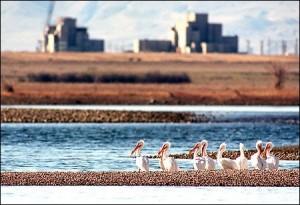forum
library
tutorial
contact

A Very Hot 15th Birthday for
Hanford Reach National Monument
by Joel Connelly
Seattle Post-Intelligencer, June 25, 2015
|
the film forum library tutorial contact |

|
A Very Hot 15th Birthday for
by Joel Connelly
|
... demonstrators from the Farm Bureau protested Clinton's action,
handing out denunciations from U.S. Rep. Doc Hastings, R-Wash.

A Hanford technician named Rich Steele devoted a quarter-century to preserving the last stretch of Columbia River in Eastern Washington that had not been turned into a reservoir behind a hydroelectric dam.
As his jet boat reached the upstream limit of the McNary reservoir, and the downstream current picked up, Steele would grin, spread his arms and announce, "Now, this ... is a river."
Fifteen years ago, President Clinton designated a 194,000-acre Hanford Reach National Monument, embracing the 47 miles of real river and desert islands -- home to the Columbia's last big wild salmon run -- as well as lands that formed a buffer flanking Hanford's nuclear reactors.
The monument curls around the Hanford Nuclear Reservation, for 45 years a center of nuclear weapons production and now site of a massive cleanup.
The 2000 celebration of the monument's designation was a political event-stager's nightmare.
Vice President Al Gore went out on the river for a fast ride on Steele's jet boat. But stiff winds exposed America's most carefully combed-over bald spot.
In Richland, demonstrators from the Farm Bureau protested Clinton's action, handing out denunciations from U.S. Rep. Doc Hastings, R-Wash.
On an earlier visit, U.S. Interior Secretary Bruce Babbitt took a walk on the slopes of Rattlesnake Mountain. He came away covered with cheatgrass from his waist to his toes.
Still, the monument, managed by the U.S. Fish and Wildlife Service, is a wonder. It has preserved the White Cliffs of Hanford, which might have been eroded had corporate agriculture been allowed to move in north of the river.
A portion of the monument, called the Arid Lands Ecology Reserve, has a big herd of Rocky Mountain Elk. The river itself is heaven for pelicans, with a healthy raptor population. At one corner of the river, you can look across the desert to a distant, dream-hazy Cascade volcano.
We have Theodore Roosevelt to thank indirectly for the Hanford Reach National Monument.
Roosevelt signed into law the 1906 Antiquities Act, which allowed the president to set aside areas for "the protection of objects of historic and scientific interest."
He took an expansive view of the law. Two early national monuments -- Mount Olympus in Washington and Grand Canyon in Arizona -- later became two of America's greatest national parks.
Sixteen presidents have used the Antiquities Act. President Obama has protected canyons in New Mexico, the compound of United Farmworkers leader Cesar Chavez, and -- in our neighborhood -- 955 wonderful acres of bays, points, islands and bluffs of the newly designated San Juan Islands National Monument.
The Antiquities Act is intensely disliked by Roosevelt's Republican successors. Doc Hastings put out a nasty statement when Obama designated a monument in the San Juans. He cosponsored legislation that would have allowed Congress to delay and kill presidential designations.
In this era of the Koch Brothers, the Club for Growth, Big Oil and Big Coal, conservation seems to have gone out of conservatism.
The Republican-run House of Representatives has taken no action to renew the Land and Water Conservation Fund (LWCF).
With money from federal oil-lease sales, the fund has been used on dozens of projects in Washington, from recreation trails to buying up old mining claims and other holdings in the Cascades. It will run out in 99 days unless reauthorized.
We're not only talking about a nation's natural and historic heritage, but that of a political party.
Our first Republican president, Abraham Lincoln, protected the Yosemite Valley. Ulysses S. Grant protected land that became Yellowstone National Park, our first park. The concept and creation of national parks is America's gift to the world.
A century later, President Reagan signed into law the Washington and Oregon wilderness bills, the Mount St. Helens National Volcanic Monument and the Columbia Gorge National Scenic Area.
What did the Gipper say about this? "What is a conservative, after all, but one who conserves," Reagan once put it. "We want to protect and conserve the land on which we live -- our countryside, our rivers and mountains, our plains, meadows and forests. This is our patrimony. This is what we leave our children."
The Hanford Reach will be sizzling this weekend, temperatures over 100 degrees. The rattlesnakes will take cover. But the Columbia River will be circulating, playing home to more than 40 species of fish. Forty-eight threatened or endangered species make their home in the monument.
What a good deed it was to spare this stretch of river, and spare the shrub-steppe lands around it from the predations of corporate agriculture.
Al Gore had to do a comb-over, and endure jokes from the press, but what a paltry price to pay for seeing and feeling one of the master rivers of North America.
learn more on topics covered in the film
see the video
read the script
learn the songs
discussion forum
